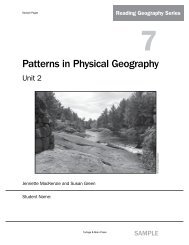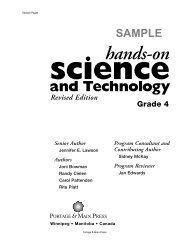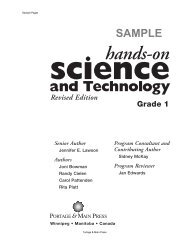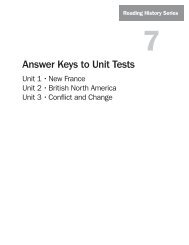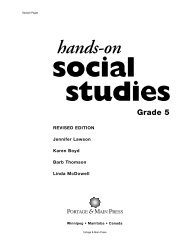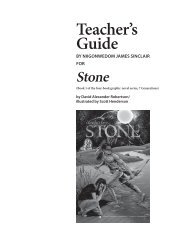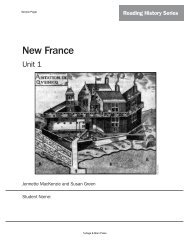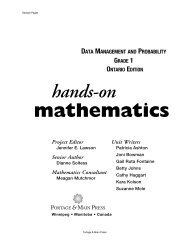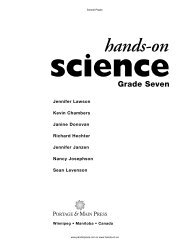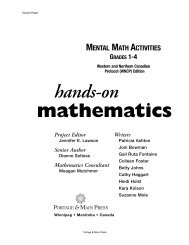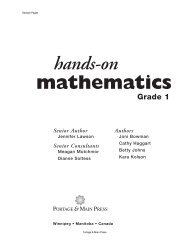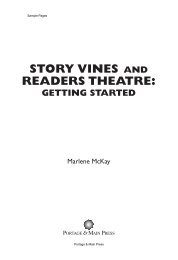People and Stories of Canada to 1867 - Portage & Main Press
People and Stories of Canada to 1867 - Portage & Main Press
People and Stories of Canada to 1867 - Portage & Main Press
You also want an ePaper? Increase the reach of your titles
YUMPU automatically turns print PDFs into web optimized ePapers that Google loves.
Sample Pages<br />
Acquiring/Applying Activities<br />
Activity 1: Reading <strong>and</strong> Mapping (BLM GM-1)<br />
Individually, have students read pages 64–66 <strong>of</strong><br />
the textbook. Give students a map <strong>of</strong> <strong>Canada</strong><br />
(BLM GM-1), <strong>and</strong> have them mark the following<br />
on their map:<br />
St. Lawrence River Hochelaga (Montréal)<br />
Stadacona (Québec) Saguenay River<br />
or<br />
Activity 2: Drawing a Map<br />
Research suggests that it is a good idea<br />
! for students <strong>to</strong> draw maps occasionally.<br />
Drawing maps helps them remember areas,<br />
<strong>and</strong> teaches them <strong>to</strong> appreciate the work <strong>of</strong><br />
mapmakers, especially those from long ago.<br />
Have students look at figure 4.17 on page 67 <strong>of</strong><br />
the textbook <strong>and</strong> draw a map <strong>of</strong> the Gulf <strong>of</strong> St.<br />
Lawrence. Then, have them close their books<br />
<strong>and</strong> redraw the map – this time from memory.<br />
Encourage students <strong>to</strong> discuss what the map<br />
shapes remind them <strong>of</strong>. Some people see the Gulf<br />
<strong>of</strong> St. Lawrence as a man’s head with a tricorn<br />
hat, <strong>and</strong> his nose is the inlet south <strong>of</strong> Gaspé.<br />
Some students see Nova Scotia as a slipper.<br />
Activity 3: Discuss <strong>and</strong> Decide What You<br />
Would Do<br />
Divide the class in<strong>to</strong> small groups, <strong>and</strong> have<br />
students discuss the following questions in their<br />
groups:<br />
✦ Who owned the l<strong>and</strong> around the Gulf <strong>of</strong> St.<br />
Lawrence?<br />
✦ Should Cartier have “claimed” the l<strong>and</strong> <strong>and</strong><br />
put up a cross?<br />
✦ Why did Cartier kidnap Donnacona <strong>and</strong> his<br />
sons? Was that the right thing <strong>to</strong> do?<br />
Activity 4: Making Protest Signs<br />
Students can make signs or take roles <strong>of</strong> First<br />
Nations people <strong>to</strong> explain why Cartier was not<br />
welcome in Stadacona on his third trip.<br />
Extension/Integration Activities<br />
Activity 1: Using a His<strong>to</strong>rical Novel<br />
Blackships, written by Rick Book, is a useful<br />
his<strong>to</strong>rical novel for this section. Have students<br />
read the book aloud <strong>to</strong> the class, or read the<br />
book aloud <strong>to</strong> the students. (A recording <strong>of</strong> the<br />
s<strong>to</strong>ry, read by Nicola St. John, is also available<br />
on CD.).<br />
!<br />
If you do this activity, make sure you<br />
emphasize that the s<strong>to</strong>ry is his<strong>to</strong>rical fiction.<br />
The facts are real, but the s<strong>to</strong>ry is not real.<br />
Explain that the author has done a lot <strong>of</strong> research<br />
about the time, using primary sources <strong>and</strong> trying<br />
<strong>to</strong> learn what really happened.<br />
Summing Up/Assessment Activities<br />
Activity 1: Questions for Discussion<br />
At the end <strong>of</strong> chapter 4, have a whole-class<br />
discussion about some or all <strong>of</strong> the following:<br />
(a) Should his<strong>to</strong>rians use the term discovery<br />
when writing about explorers reaching new<br />
l<strong>and</strong>s? Who discovered whom?<br />
(b) Should Europeans have “claimed” the l<strong>and</strong>s <strong>of</strong><br />
the Americas?<br />
(c) If you were an Aboriginal person, how would<br />
you feel about a stranger claiming l<strong>and</strong> your<br />
family had lived on for generations?<br />
(d) If you were a European explorer, how would<br />
you feel about claiming new l<strong>and</strong>s that people<br />
were already living on?<br />
(e) What do you think Europeans who wanted <strong>to</strong><br />
travel <strong>to</strong> the Americas should have done?<br />
(f) Go back <strong>to</strong> A Mi’kmaq S<strong>to</strong>ry in the goldcoloured<br />
box on page 53. Reread the last<br />
paragraph. What do you think the Elders <strong>of</strong><br />
the Mi’kmaq could have done if they had<br />
been able <strong>to</strong> interpret the dream?<br />
<strong>Portage</strong> & <strong>Main</strong> <strong>Press</strong><br />
The Europeans Come <strong>to</strong> North America 111



